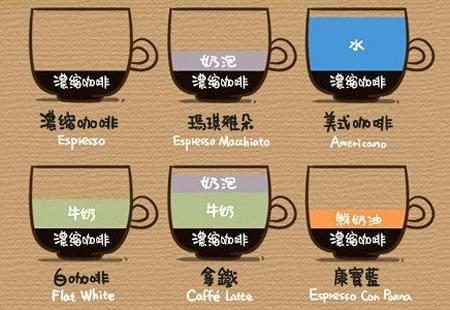Introduction to common types of coffee

You hear a lot about coffee, but do you know the names of coffee? What are the common coffee, its practices and ingredients? A few days ago, a website in Taiwan organized and drew such a lovely picture for everyone, so that you can see the composition of coffee at a glance. Read this article and you will know. Next time you go to a coffee shop, don't ask them what you should drink.
Espresso, Italian for "immediately brewed for you," is commonly known as Italian espresso. Espresso uses high pressure to allow boiling water to quickly pass through the coffee powder in just a few seconds, resulting in about 1/4 ounce of coffee, bitter and strong.
Espresso Macchiato. Macchiato is Italian for "imprint," pronounced "macchiato," but we used to call it macchiato. Macchiato is strong coffee with a thin layer of hot milk foam to maintain coffee temperature, delicate sweet milk foam can buffer the bitter impact of espresso coffee, want to drink coffee but can not give up sweet you, you can choose macchiato.
Americano coffee. Black coffee made using drip coffee pots, siphons, french presses, etc., or espresso coffee made with plenty of water. The taste is lighter, but because of the long extraction time, the caffeine content is high.
Coffee (Flat White). Malaysia's local products, about 100 years of history. White coffee does not mean that the color of coffee is white, but the use of special coffee beans and super skim milk raw materials, after special processing of coffee, glycol aroma does not hurt the stomach, retain the original color and aroma of coffee, color is lighter than ordinary coffee, so it is named white coffee.
Caffè Latte. Latte coffee is extremely simple to make, just pour the milk into the freshly made espresso. In fact, there are no fixed rules on how much milk is added, and it can be freely mixed according to personal taste.
Espresso Con Panna. In Italian, Con means stir, Panna means whipped cream, and Campo Lan means espresso with whipped cream. There is a saying that authentic Kang Baolan should be accompanied by a chocolate or toffee, first chocolate or toffee in the mouth, then drink coffee, so that delicious together in the mouth bloom.
Cafe Breve/Half latte. Much like latte, except instead of milk, it's a mixture of half milk, half cream, and sometimes a little foam.
Cappuccino. A traditional cappuccino is one-third espresso, one-third steam milk and one-third frothy milk. Cappuccino comes in both dry and wet forms. Dry Cappuccino refers to a method of conditioning with more milk bubbles and less milk, which makes coffee taste stronger than milk. Wet Cappuccino refers to the practice of less milk foam and more milk, and the milk fragrance covers the strong coffee flavor, which is suitable for light tastes.
Caffè Mocha. One of the oldest coffees, named after the famous port of mocha. Mocha is a blend of espresso, chocolate syrup, whipped cream and milk, a variant of Italian latte.
Caramel Macchiato. Caramel macchiato is a drink made by adding espresso, vanilla and pure caramel to hot milk. It is characterized by three different flavors in one drink.
Irish Coffee (Irish Coffee) A coffee that resembles both wine and coffee and is a blend of hot coffee, Irish whiskey, cream, and sugar.
Viennese coffee. Austria's most famous coffee, in the bottom of the warm coffee cup sprinkled with a thin layer of sugar or fine rock sugar, then poured into the cup hot and strong black coffee, and finally in the coffee surface decorated with two spoonfuls of cold fresh cream, a cup of Viennese coffee is ready.
Important Notice :
前街咖啡 FrontStreet Coffee has moved to new addredd:
FrontStreet Coffee Address: 315,Donghua East Road,GuangZhou
Tel:020 38364473
- Prev

Peter Cat: the past Life and present Life of Haruki Murakami's Private Jazz Cafe
If you are a reader of Haruki Murakami, you are no stranger to the idea that he is a serious jazz fanatic. In Japan in the sixties and seventies of the last century, Murakami was as confused and agitated as his college students of the same age. the difference is that he had a tendency to avoid the world. American literature and jazz are undoubtedly his ways to escape from the real world around him. Until now, he can still recite it in one breath.
- Next
Decrypting Delicious Turandot Coffee
In 1748, the French first introduced coffee trees from Cuba's neighboring Haiti to the island of Cuba. For the next 50 years, coffee cultivation was not valued in Cuba until the end of the 18th century. The flood of the French Revolution spread to Haiti. Many French people went to Cuba, so coffee cultivation developed. Turandot introduces Cuba's famous
Related
- How did the Salvadoran coffee industry develop in Central America?
- What exactly does the golden cup extraction of coffee mean?
- The Origin of Coffee flower
- [2023 Starbucks World Earth Day] there are more meaningful things besides free Starbucks coffee!
- What kind of coffee is there in Spain? 9 Flavors of Spanish Coffee
- Aromatic African coffee| Kenya's coffee culture and historical production area
- Liberica Coffee Bean knowledge: the characteristics of Liberian Coffee beans of the three original species of Coffee beans
- The origin and formula of Spanish latte introduces the taste characteristics of Bombon coffee in Valencia, Spain.
- How to adjust the solution of over-extracted coffee
- What is the tasting period of coffee beans? What is the period of coffee and beans? How should coffee wake up and raise beans?

